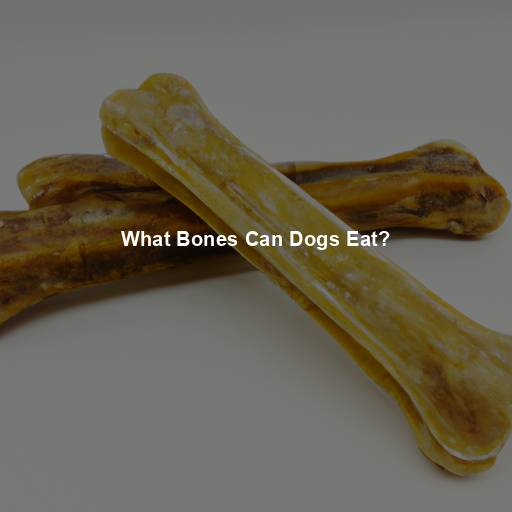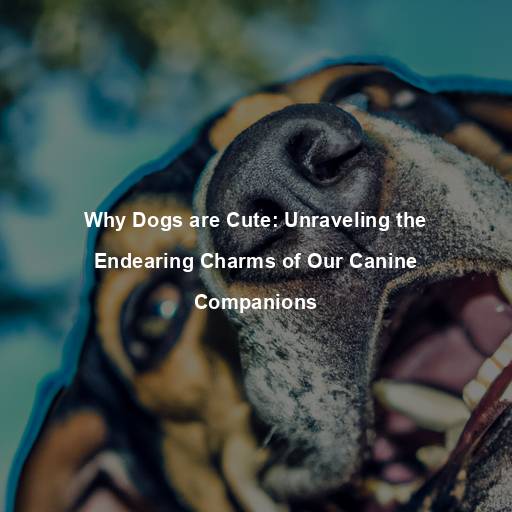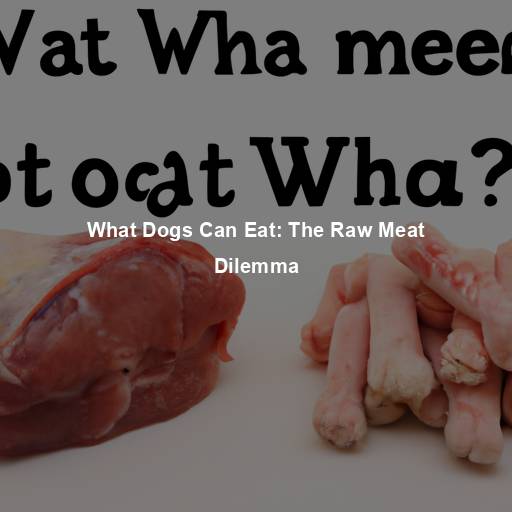What Bones Can Dogs Eat?
Last Updated on July 18, 2023 by Evan
Contents
- 0.1
- 0.2 The Natural Instinct to Chew
- 0.3 Dental Health Benefits
- 0.4 Nutritional Value
- 0.5 The Dangers of Feeding Bones to Dogs
- 0.6 Choking and Obstruction Hazards
- 0.7 Intestinal Blockages and Perforations
- 0.8 Dental Fractures and Injuries
- 0.9 Safe Bones for Dogs to Eat
- 0.10 Raw Meaty Bones
- 0.11 Edible Bones
- 0.12 Veterinary-Approved Bones and Alternatives
- 0.13 Precautions When Feeding Bones to Dogs
- 0.14 Size Matters
- 0.15 Supervision and Time Limits
- 0.16 Proper Storage and Disposal
- 0.17 Salmonella and Bacterial Contamination
- 0.18 Aggressive Chewing and Resource Guarding
- 0.19 Allergic Reactions and Digestive Sensitivities
- 1 Alternative Chews and Toys for Dogs
- 2 Consulting with Your Veterinarian
- 3 FAQs – What Bones Can Dogs Eat?
- 3.1 Can dogs eat bones?
- 3.2 What types of bones are safe for dogs?
- 3.3 Are there any bones that dogs should NEVER eat?
- 3.4 Why are cooked bones dangerous for dogs?
- 3.5 Can I give my dog bone treats or bones from the pet store?
- 3.6 How should I give bones to my dog?
- 3.7 Can I give my dog large beef bones to chew on?
- 3.8 Are there any alternative options to bones for dogs?
The discourse surrounding the practice of feeding bones to our beloved four-legged friends has ignited an ongoing debate that seems to elude a simple resolution. Pet owners and veterinary professionals alike find themselves ensnared in a perplexing web of opposing viewpoints. On one side of the spectrum, proponents argue that bones offer a plethora of benefits, from entertainment to vital nutrients for our canine companions. However, this line of reasoning encounters staunch resistance from those who caution against the latent perils bones may entail, such as choking, intestinal blockage, and dental fractures.
The Natural Instinct to Chew
Dental Health Benefits
One of the primary reasons why dogs are drawn to bones is their natural instinct to chew. Just like humans, dogs have a strong urge to gnaw on objects to satisfy their chewing needs. Chewing on bones can help keep their teeth clean by reducing plaque and tartar buildup, preventing dental issues such as periodontal disease. The act of gnawing can also provide mental stimulation and alleviate boredom, especially for dogs who spend a significant amount of time alone.
Nutritional Value
When it comes to canine nutrition, bones can play a surprising role in providing some tail-wagging benefits. It turns out that raw bones hold the key to a pupper’s overall health, offering a tantalizing array of essential nutrients like calcium, phosphorus, and trace minerals. These not-so-ordinary treats are particularly vital for our precious puppies and wise old hounds, who have unique dietary needs. However, pet parents need to exercise caution and fetch the right kind of bones, expertly prepared, to avoid any unexpected ruffness.
The Dangers of Feeding Bones to Dogs
Choking and Obstruction Hazards
While bones can provide various benefits, it’s essential to be aware of the potential dangers they pose. One of the greatest risks associated with feeding bones to dogs is choking. Bones, especially small or irregularly shaped ones, can become lodged in a dog’s throat, blocking their airway and causing breathing difficulties. This can be a life-threatening situation that requires immediate veterinary intervention.
Intestinal Blockages and Perforations
Another significant risk is the potential for intestinal blockages or perforations. When dogs chew on bones, they may break them into sharp fragments that can cause serious damage to their digestive system. These bone fragments can become lodged in the esophagus, stomach, or intestines, leading to blockages or even perforations. Ingesting bones can also cause constipation, abdominal pain, vomiting, and diarrhea, which may require surgical intervention to resolve.
Dental Fractures and Injuries
When it comes to the safety of our canine companions, bones can be a bit of a double-edged sword. While they may provide dental health benefits, there is also a perplexing possibility of them posing a risk to our furry friends’ teeth. Especially those weight-bearing behemoths like large beef bones, they can be surprisingly bursty and cause dental fractures or breakage that leave our beloved pets in discomfort. So, it’s of utmost importance to navigate this perplexity by considering factors such as size, strength, and type of bone before blissfully offering it as a treat to our furry friends.
Safe Bones for Dogs to Eat
Raw Meaty Bones
When it comes to selecting bones for your dog, raw meaty bones (RMBs) are generally considered the safest option. RMBs are uncooked bones that still have meat attached to them. They are softer and more pliable than cooked bones, making them less likely to splinter and cause harm. Examples of RMBs include chicken wings, turkey necks, and beef ribs.
Edible Bones
Edible bones, such as raw chicken or turkey bones, are another safe option for dogs. These bones are soft and easily digestible, minimizing the risk of choking or causing intestinal blockages. It’s important to note that cooked bones should never be given to dogs, as they become brittle and prone to splintering, posing a significant hazard. Stick to raw or dehydrated bones to ensure the safety of your furry friend.
Veterinary-Approved Bones and Alternatives
If you find yourself feeling uncertain about which bone is the right fit for your furry friend, it’s always a good idea to seek the advice of a veterinary professional. With their expert knowledge and consideration of factors such as your dog’s size, age, and overall well-being, they’ll be able to offer personalized guidance. In certain cases, veterinarians might suggest exploring alternative options like dental chews or specialized toys that are specifically formulated to promote dental health without the potential dangers that come with feeding actual bones. Rest assured, these alternatives can still give your pup the satisfaction of chewing while minimizing any potential risks.
Precautions When Feeding Bones to Dogs
Size Matters
When it comes to bones for your furry friend, let’s talk size, shall we? It’s crucial to consider your dog’s breed and size when selecting the perfect bone. For those big, majestic canines, opt for larger bones to ensure they can enjoy their chew without any risks. On the other paw, smaller dogs deserve bones that match their petite stature, avoiding any potential choking troubles.
Supervision and Time Limits
As devoted dog owners, it’s essential to keep a watchful eye on our furry companions during their bone-chewing endeavors. Life can be unpredictable, and it’s always better to err on the side of caution. One never knows when an unfortunate choking incident might occur, requiring our immediate assistance. Moreover, it’s crucial to remember that moderation is key to maintaining your canine’s oral and digestive health.
Proper Storage and Disposal
Storing bones properly is essential to prevent spoilage and bacterial growth. Keep raw bones in the refrigerator or freezer to maintain their freshness. Dispose of any leftover bones that have been chewed on to prevent your dog from consuming small or sharp fragments. If your dog loses interest in a bone or if it becomes too small, discard it and replace it with a new one to maintain their safety.
Salmonella and Bacterial Contamination
In addition to the risks previously mentioned, feeding bones to dogs can also expose them to bacterial contamination, such as Salmonella. Raw bones, in particular, carry a higher risk of bacterial presence, which can lead to foodborne illnesses in both dogs and humans. It’s crucial to handle and store bones properly, ensuring that they are sourced from reputable sources and handled with strict hygiene measures. If you choose to feed your dog raw bones, consult with your veterinarian to understand the potential risks and necessary precautions.
Aggressive Chewing and Resource Guarding
When it comes to feeding bones to our furry friends, things can get a bit hairy. Some dogs, especially when they’re in the presence of other pups or possessive tendencies, can become downright aggressive. It’s important to keep an eagle eye on your pooch’s behavior while they’re chomping away and nip any signs of aggression in the bud. If resource guarding becomes a problem, it might be time to bring in the big dogs – professional trainers or behaviorists – to help guide you through these ruff waters.
Allergic Reactions and Digestive Sensitivities
When it comes to giving your furry friend a bone to chew on, it’s important to tread with caution. Just like humans, dogs can have their fair share of food allergies and digestive sensitivities. So, before you toss Fido a bone, be aware that certain types, like those derived from chicken or turkey, might not sit well with dogs who are allergic to poultry. Even if a bone is considered safe for consumption, some pups with sensitive stomachs or a history of gastrointestinal issues could wind up feeling less than stellar after indulging.
Alternative Chews and Toys for Dogs
For those who may feel uneasy about giving their furry companions bones or simply prefer to explore other options, fret not! There exists a variety of alternative chews and toys that can offer just as many advantages. These options provide a similar level of enjoyment and keep your pup happily entertained, all while addressing any concerns you may have about potential risks. Embrace the diverse range of options available, and rest assured that you can still provide your dog with the best chew experience possible!
Dental Chews
Dental chews are specifically designed to promote dental health and satisfy a dog’s chewing needs. These chews are typically made from materials that are safe for dogs to chew on, such as rubber or nylon. Dental chews come in various shapes and sizes, and some even have ridges or bristles to help remove plaque and tartar. Look for dental chews that are approved by veterinary professionals and suitable for your dog’s size and breed.
Interactive Toys and Puzzle Feeders
Looking to keep your furry friend entertained and mentally sharp? Look no further than the world of interactive toys and puzzle feeders. These mind-boggling contraptions are specifically designed to challenge your dog’s problem-solving abilities while rewarding them with tasty treats. Whether it’s navigating through intricate puzzles or manipulating cleverly designed toys, these mental stimulators offer a refreshing change from the traditional bone chewing routine.
Kong Toys and Food Dispensers
Pet owners are always on the hunt for top-notch toys that will not only entertain their furry friends but also keep them mentally engaged. Look no further than the renowned Kong toys and food dispensers, which have gained significant popularity among savvy dog owners. Crafted from sturdy rubber, these toys are designed to withstand even the most determined chewers. The real magic lies in their hidden treasure trove of treats, peanut butter, or kibble that can be stuffed inside – turning playtime into a tantalizing challenge for dogs who possess the necessary intellect and curiosity.
Consulting with Your Veterinarian
Considering adding bones or other chew toys to your furry friend’s routine? It’s absolutely vital to reach out to your trusted veterinarian for their professional guidance beforehand. Each pup is unique, and your vet will provide tailored advice taking into account your dog’s individual requirements, like any dietary restrictions, dental care considerations, or behavioral quirks. Rest easy knowing that your vet will steer you in the right direction, recommending safe options and helping you choose the perfect chew or toy for your pup.
Remember, every dog is different, and what works for one may not work for another. It’s important to prioritize your dog’s safety and well-being when choosing how to satisfy their chewing needs. By understanding the potential risks and benefits, consulting with professionals, and monitoring your dog’s behavior, you can make informed decisions about feeding bones or selecting alternative options that will keep your furry friend happy and healthy.
FAQs – What Bones Can Dogs Eat?
Can dogs eat bones?
It’s a common query among dog owners: can our furry friends truly indulge in the joy of chewing on bones? Well, the verdict is somewhat confounding. While it is true that some bones are deemed safe for dogs, the line between safety and peril can be rather perplexing. Hence, it becomes imperative for dog guardians to be vigilant and proceed with utmost caution, ensuring that these crunchy delights do not pose any health hazards to our beloved four-legged companions.
What types of bones are safe for dogs?
When it comes to treating our furry friends, there’s always a bone of contention – but fear not, for I bring you some bone-chilling news. Believe it or not, raw meaty bones like beef or chicken bones can actually be a canine’s delight. Surprisingly, these bones prove to be more tender and less brittle than their cooked counterparts, lessening the risk of shattering and any potential digestive distress for your beloved pup. So, go ahead and give them something to really sink their teeth into – with a side of peace of mind.
Are there any bones that dogs should NEVER eat?
It’s a common misconception that dogs can devour any bone that comes their way, but the truth is, not all bones are created equal when it comes to our furry friends. Among the bones that should be off-limits for dogs are the cooked ones, especially those from poultry like chickens or turkeys. You see, the cooking process leaves these bones fragile and susceptible to shattering into sharp fragments, posing a grave risk to a dog’s delicate mouth, throat, and even their digestive system.
Why are cooked bones dangerous for dogs?
When it comes to our furry friends, safety is of utmost importance. That’s why it’s crucial to understand the risks of feeding cooked bones to your dogs. Cooked bones, unfortunately, have a tendency to become fragile and break into sharp shards, causing potential harm to your dog’s oral and digestive health. The dangers range from punctured gums and lacerations to more severe outcomes like internal bleeding or blockages.
Can I give my dog bone treats or bones from the pet store?
When it comes to spoiling our furry companions, caution should never be thrown to the wind. Not every bone treat or store-bought bone is bestowed with the paw of safety for our beloved canines. Hidden within the aisles of pet shops lie bone treats that have undergone curious processing methods, infiltrated with artificial flavors and suspicious preservatives that could taint the health of our loyal companions. A prudent approach is to diligently peruse the product label and seek the guidance of a trusted veterinarian before offering any store-bought bones or treats to our cherished four-legged friends.
How should I give bones to my dog?
When it comes to letting your furry best friend indulge in raw meaty bones, it’s crucial to keep a watchful eye on them as they chomp away. This is to ensure their safety and steer clear of any unwanted incidents like choking or tummy troubles. And remember, it’s essential to choose bones that suit your dog’s size to dodge any unforeseen risks.
Can I give my dog large beef bones to chew on?
Large beef bones can potentially harm your dog’s teeth due to their hardness. Furthermore, they may have a risk of fracturing your dog’s teeth or causing mouth injuries. It is generally advised to consult with your veterinarian before offering large beef bones as chew toys to your canine companion.
Are there any alternative options to bones for dogs?
Yes, there are alternative options to bones for dogs. Chew toys made specifically for dogs can provide mental stimulation, exercise their jaws, and satisfy their chewing instinct. You can also consider offering dental chews or specially designed treats that promote oral health while providing a safe chewing experience for your dog.
When it comes to treating your furry friend with bones or chew toys, it’s essential to seek guidance from a trusted veterinarian. They can help assess your dog’s unique needs, taking into account factors like age, size, dental health, and other personal considerations. Don’t leave anything to chance and ensure your pup gets the best advice for their happy and healthy chewing experience.





